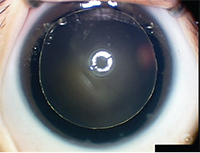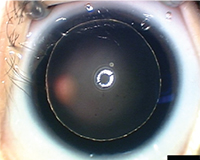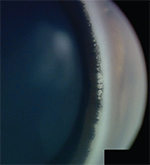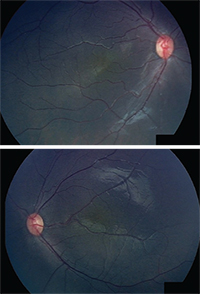 | |
 |  |
| Figure 1. Right (top) and left eyes, demonstrating near total absence of iris tissue. | Figure 2. Iris processes spanning a dysgenic trabecular meshwork. |
A 7-month-old boy was referred for nystagmus of both eyes. His parents reported the nystagmus started at 1 month of age. On initial evaluation he was found to have bilateral aniridia.
Medical History
The patient was the product of a normal pregnancy and uncomplicated repeat cesarean section. Birth weight was 5 pounds. Family history was unremarkable—there were no other family members with aniridia. He had one sibling, a healthy 2-year-old brother.
Examination
His extraocular motility was full without strabismus, and he was able to fix and follow with no preference for fixation with either eye. He demonstrated horizontal moderate frequency and moderate amplitude symmetric bilateral nystagmus with a null point in primary position. There was no anomalous head positioning.
 |
| Figure 3. Foveal hypoplasia with anomalous vessels present in the right (top) and left eyes. |
Funduscopic evaluation disclosed normal optic nerves with moderate macular hypoplasia in each eye with anomalous vessels in the maculas (See Figure 3).
Please click this link for diagnosis, workup, treatment and discussion.



